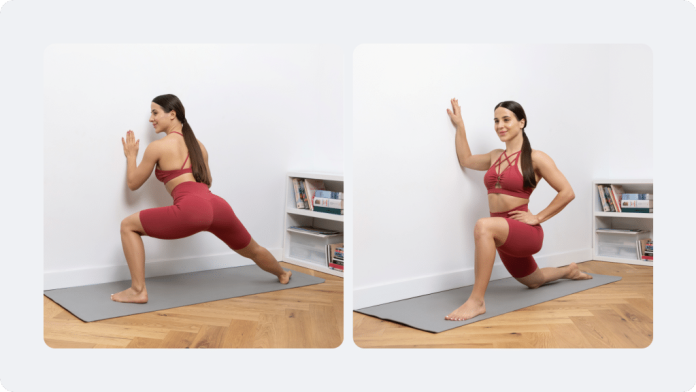Ever heard the phrase, “Sometimes, simplicity is key”? That’s exactly what the wall plank exercise is all about. This no-fuss exercise uses your body weight and a wall to challenge your core strength, stability, and overall fitness. Despite its simplicity, the wall plank is packed with potential benefits. It can strengthen your core, improve balance and posture, and even enhance flexibility. So, if you’re looking for an effective and straightforward exercise to add to your routine, the wall plank is definitely worth trying.
Benefits of Wall Plank Exercise
Wall plank exercise, like its cousin, the floor plank, has many incredible benefits that it offers to its practitioners.
Strengthens the Core
The wall plank exercise is a dynamo when it comes to toning your abs, obliques and lower back. The beauty is in its simplicity and effectiveness. By engaging your core muscles during the plank, you can build a strong and stable midsection.
Improves Balance and Posture
A well-executed wall plank doesn’t just build muscle. It can help to improve your balance and posture, too. An improved posture can make all the difference in your day-to-day activities. By maintaining proper alignment during the plank, you train your body to maintain good posture even when not exercising.
Enhances Flexibility
Bet you didn’t see this one coming! But yes, the wall plank also enhances your flexibility, especially in your posterior muscle group, including the shoulders, hamstrings and even the arches of your feet. As you hold the plank position, these muscles are gently stretched, leading to increased flexibility over time.
Precautions to Take Before Performing Wall Plank Exercise
Like any exercise, it’s important to approach the wall plank with care. Make sure your hands are dry to prevent slipping, and always listen to your body. If something doesn’t feel right, it’s better to stop and adjust or seek professional advice. It’s also a good idea to start with shorter hold times and gradually increase as you build strength and endurance.
Step-by-Step Guide to Doing a Wall Plank Exercise
Now that we’ve talked about the benefits and precautions, let’s get down to business. How exactly do you perform a wall plank exercise?
Preparing for the Wall Plank
Stand facing a wall about a couple of feet away. Prepare yourself mentally for the exercise ahead. Remember, it’s not a race. Take it at your own pace. Take a few deep breaths and engage your core before starting.
Getting into Position
Extend your arms and place your palms flat against the wall. Walk back with your feet until your body is at a slight angle. It should be a straight line from your head to your heels. Make sure your hands are shoulder-width apart, and your feet are together.
Holding the Plank
Engage your core and hold this position. Don’t let your hips sink or your butt stick out. Keep everything in line. This is the challenging part, but you’ve got this! Aim to hold for 20-30 seconds to start, and gradually increase your hold time as you get stronger.
Releasing the Plank
Slowly walk back towards the wall and gently release your arms. You did it! That’s one wall plank down. Take a moment to catch your breath before moving on to your next set or exercise.
Variations of Wall Plank Exercise
Once you’ve mastered the basic wall plank, why not challenge yourself with some variations?
Knee Wall Plank
In this variation, as you walk your feet back, keep your knees bent. This can help target different muscle groups. Specifically, the knee wall plank places more emphasis on the lower abs and can be a good option for those with wrist issues.
Straight-Arm Wall Plank
Instead of bending your arms in the plank position, keep them straight. This variation can work your shoulders more. It also places more emphasis on the upper chest muscles.
Incorporating Wall Planks into Your Workout Routine
Wall planks are versatile. You can add them to your warm-up, use them as part of your main workout, or even include them in your cool-down session. The key is consistency. Try to incorporate wall planks into your routine 2-3 times per week to start, and gradually increase frequency as your strength improves.
Common Mistakes and How to Avoid Them
Like any exercise, it’s easy to make mistakes with wall planks. Some common ones include letting the hips sag, not keeping the body in line, and not engaging the core. But don’t worry – awareness and practice can help correct these issues. Always focus on maintaining a straight line from head to heels, and actively engage your core throughout the exercise. If you find yourself struggling with form, don’t be afraid to take a break and reset before trying again.
FAQs
As a beginner, aim for 10-30 seconds per set. As you get stronger, you can increase this time.
This will depend on your fitness level and goals, but a good starting point is 2-3 times per week.
Yes, when done correctly, wall planks can strengthen the core muscles, which in turn can help support your back and reduce pain.
Always consult your doctor or a fitness professional before starting any new exercise during pregnancy.
While they can’t target fat loss in one specific area, wall planks can help increase overall body strength and fitness, which can contribute to weight loss when combined with a healthy diet.
Conclusion
The wall plank exercise is a simple yet powerful fitness tool that strengthens the core, improves balance and posture, and enhances flexibility. Despite its simplicity, it offers various challenging variations to keep your workouts engaging. Incorporating wall planks into your routine consistently can lead to significant benefits in overall strength and stability. So, adopt this unassuming exercise, practice regularly, and start enjoying the positive impact it can have on your fitness journey.


